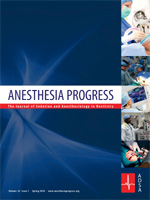October 9, 2021 (Global News Distribution) -
Treatment safety and efficacy are extremely important when performing pediatric dental procedures. A new study, published in Anesthesia Progress, found that the use of epinephrine pellets during pediatric zirconia crown placements had positive outcomes in both the safety and efficacy of each treatment.
Anesthesia Progress – The most common chronic disease children experience is dental caries, and routine pediatric dental care is a necessity that assists in oral and whole-body health. However, the majority of children will still require some form of restorative dental care, and that increases in those who do not receive routine dental checkups. Treatment safety and efficacy is imperative when performing pediatric dental procedures.
Researchers from the University of Washington, Seattle; Evidinno Outcomes Research Inc., Vancouver, British Columbia, Canada; and the University of Missouri–Kansas City School of Dentistry, Kansas City, Missouri, recently published a single-blinded, crossover/split-mouth randomized controlled trial in the current issue of Anesthesia Progress that compared cardiovascular safety and hemostatic efficacy of topical epinephrine with a saline placebo.
A total of 13 patients (54% males/46% females), ranging in age from 2.7 to 7.8 years and requiring zirconia crowns on primary maxillary first molars, participated in this study. The researchers measured heart rate (HR), diastolic and systolic blood pressure (D/SBP), and mean arterial pressure (MAP) while the patient was under general anesthesia to monitor cardiovascular function, as well as tracking the time to achieve hemostasis as a measure of clinical efficacy. The patients’ HR, D/SBP, and MAP were recorded immediately before (baseline) epinephrine or saline pellet placement, and then at 1, 2, 3, 4, and 5 minutes after pellet removal.
The researchers found significant decreases in HR, D/SBP, and MAP from baseline to 5 minutes after treatment with epinephrine. In the placebo group, there were significant decreases in HR and SBP, but no significant change in DBP or MAP. During the recording times, there were no clinically significant changes in cardiovascular measurements, and no adverse events in either group. Researchers also note that all 13 teeth in the epinephrine group achieved adequate hemostasis in 2.2 minutes, while only 5 of 13 placebo teeth reached hemostasis within the 5-minute observation window; the remaining 8 teeth required a local anesthetic injection and application of direct pressure to achieve hemostasis.
The results of this study suggest that the use of epinephrine pellets during zirconia crown placement under general anesthesia in children has no negative cardiovascular effects and hemostasis is reached quicker and more effectively. On the findings of this study, lead author Afsoon Fazeli states, “We were reassured by study results but hope there are more clinical studies done so dentists can feel confident in using the epinephrine pellets to improve their efficiency during procedures without concerns about cardiovascular side effects.”
Full text of the article, “Cardiovascular Safety and Hemostatic Efficacy of Topical
Epinephrine in Children Receiving Zirconia Crowns,” Anesthesia Progress, Vol. 68, No. 3, 2021, is available at: https://meridian.allenpress.com/anesthesia-progress/article/68/3/133/471172/Cardiovascular-Safety-and-Hemostatic-Efficacy-of
About Anesthesia Progress
Anesthesia Progress is the official publication of the American Dental Society of Anesthesiology (ADSA). The quarterly journal is dedicated to providing a better understanding of the advances being made in the science of pain and anxiety control in dentistry. The journal invites submissions of review articles, reports on clinical techniques, case reports, and conference summaries. To learn more about the ADSA, visit: http://www.adsahome.org/.






